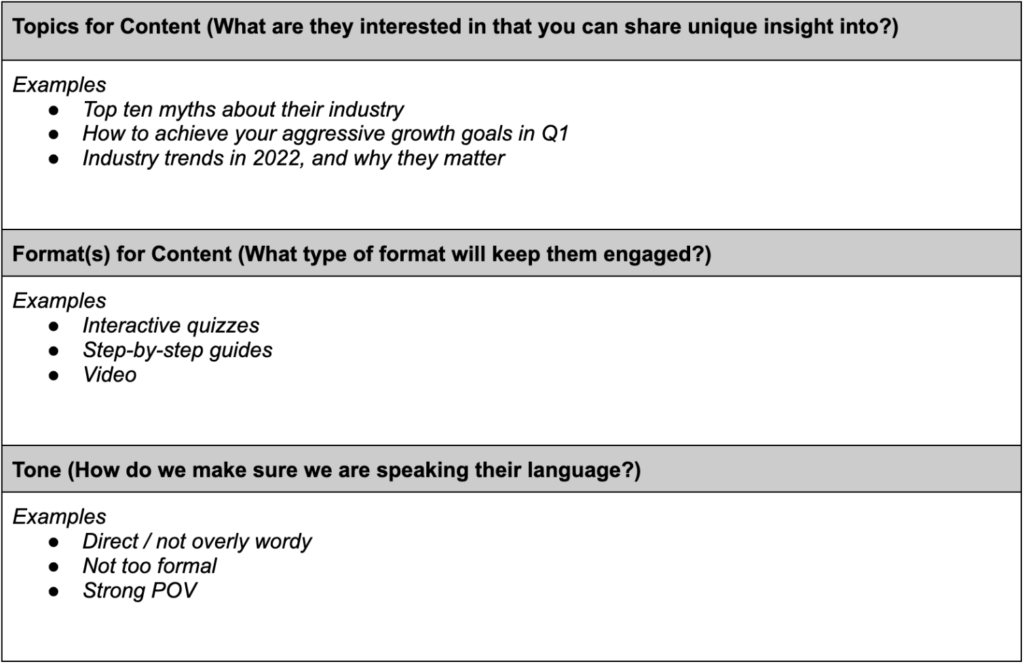In the early days of your startup, building your content marketing strategy isn’t necessarily easy, but the process should be straightforward. After all, your team is small, and you know your tech and your target audience better than anyone. Providing real value to your audience can happen without a huge investment of time or money. (Don’t believe me? Check out our Winning with Content Marketing and DIY Marketing crash courses.)
But what happens after you start to get some momentum? Your team grows and changes—and so does your audience. Has your understanding of your target audience shifted at all, since the early days of your startup? (It likely has.) Does everyone on your growing team understand your audience equally well? (They may not.) Do you have a better (or worse) understanding of which content is resonating, and why?
These are normal questions to ask yourself as your startup grows. In fact, these are questions we found ourselves asking recently at Blue Seeding. In the past two years, we grew a lot. We added new types of clients, and we welcomed eight new team members. Our audience had changed, and so had we. Did our content still line up with our new identity?
To tackle these big questions, we planned a content marketing reboot session, to help refresh our understanding of our audience — and how we can best deliver value to them. Much like recent reboots of Full House, Fresh Prince, and Saved by the Bell, the goal of this session was not to fundamentally change who we were. Rather, we wanted to figure out how to adapt to new times — and create an exciting new content plan that would meet (and exceed) the needs of our growing audience.
The session left us with fresh ideas for blog posts, newsletters, webinars, and social media content. And crucially, we collaboratively developed a new, shared understanding of who our audience is and what they are hungry for.
Wondering how you can do the same? Use our content reboot session workbook below to help energize your team around a shared understanding of your audience—and plan all the valuable, creative, mind-blowing content you’ll create for them.
P.S. You can also view the content reboot session workbook here, and then make a copy of the document to use during your own session. Have fun, and happy rebooting. 🚀
Content Reboot Session
Format Note: All marketing stakeholders on your team should attend this session. This includes all members of the marketing team, any frequent marketing contractors/collaborators, and also any leaders who actively participate (or want to participate) in creating content (e.g. a CEO/founder who is very active on Twitter, any folks who work on Sales enablement content, anyone on the team who is an industry thought leader.) We recommend reserving about 90 minutes for this session.
Agenda
Part One: Goal-Setting & ICP Sync
Part Two: Audience Deep Dive
Part Three: Content Strategy Session
Part Four: Wrap-Up
Part One: Goal-Setting & ICP Sync (~20 minutes)
In this first section, you will first set your goals for the session, and then if applicable, work together to briefly sync on your ICP (Ideal Customer Persona). If your team is already clear on who your ICP is, feel free to skip this section. But it’s often helpful to remind everyone who your ICP is at the top of this workshop.
We recommend tackling both these sections as a group discussion. Appoint a designated facilitator to lead the discussion and make sure everyone is participating equally, and make sure someone else is taking notes.
Goal-Setting (3 minutes)
Discussion Question: What are our goals for this session?
Engagement idea: go around the room, and have everyone share one personal goal for this session.
ICP Sync (Optional) (15-20 minutes)
Group Activity: What is our ICP (Ideal Customer Profile)?
Fill out the following section as a group to help define the type(s) of customers you are targeting.
1) Company
- Type / Industry:
- Geographic location(s):
- Size:
- Revenue:
- Number of employees:
- Technologies used (if applicable):
- Funding stage (public, funding round for startups):
- Company news/intent signals (e.g. expanding to new geographies):
- Exclusions (Attributes or specific companies to exclude for various reasons):
Examples:
Marketing/advertising agencies, 100+ employees, NYC metro area
Fashion retailers and brands, $1B in revenue, USA
2) Person
- Function/department:
- Size of department:
- Seniority level:
- Geographic location:
- Exclusions: (Attributes or specific companies to exclude for various reasons):
Examples:
Marketing, Director level and above (including “Head of”), East Coast
Social media or influencers, manager level, Europe
Part Two: Audience Deep Dive (~30-45 min)
Now that you’ve defined your ICP, get to know your audience even better. Divide into small groups (3-4 people max) for this activity. Each small group should choose one real customer (a specific person, not just a company) and fill out the details below. Ideally, the person you choose should have been involved with the initial decision to buy your product/service. Also, this customer should generally be a good fit for your startup. After 15-20 minutes, come back together as a group, and share your customer profile.
Basic Details
- Name:
- Job Title:
- Company Name:
- Home Base:
- Short Founder Origin Story (if any):
- Short Professional Bio:
- Area(s) of Expertise/Specialization:
- What is the top reason they decided to work with us?
Psychographics
- Describe their personality in 3 words:
- Describe their working style in 3 words:
- Current Goals:
- Current Challenges:
- Current Knowledge Gaps and Obstacles:
- What Gets Them Excited:
- What Keeps Them Up at Night:
- What Animal Would They Be:
Company Details
- Company Name:
- Company Size:
- Revenue (if known):
- Number of Employees:
- Funding Stage:
- At the beginning of the engagement, what were the latest company news / intent signals? (Eg expanding to new geographies, new funding round, etc.)
Part Two Wrap-Up
After your small groups have shared their customer profiles, the whole group should answer the following questions.
- What did the customers we just discussed have in common?
- What generalizations can we make about our customers based on the profiles above?
- Are there any characteristics that are common in our audience that aren’t captured in the profiles above?
Part Three: Content Strategy Session (~30 min)
Knowing what you now know about your audience, what content can you create that will be valuable & actionable for them? Fill out the chart below as a group. Make sure you also share why you think each idea will be effective, based on today’s conversation.

Part Four: Wrap-Up
Wrap up by defining your action items, and answering the following questions as a team. We recommend going around the room and having each person share their answers to one or all of these questions.
- What did you learn today?
- What’s one idea for content that you’ll run with after today’s session?
- What are you excited about, content-wise?
- What do you still have questions about?








